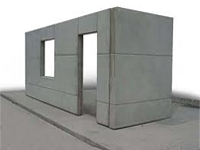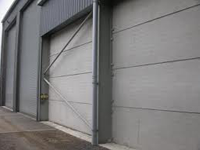Precast Wall Panels, Precast Concrete Wall Panel, Readymade Wall Panels, Precast Compound Wall Panels !
We, Style Earth Precast concrete (P) ltd, Bangalore, India; Manufactrures and Suppliers of Precast Wall Panels, Readymade Wall Panels, Concrete Wall Panels, Precast Concrete Wall Panel, Precast Compound Wall Panels, Precast Concrete Products and Stone Products.
Architectural precast concrete has been used since the early twentieth century and came into wide use in the 1960s. The exterior surface of precast concrete can vary from an exposed aggregate finish that is highly ornamental to a form face finish that is similar to cast-in-place. Some precast panels act as column covers while others extend over several floors in height and incorporate window openings.
In most cases, the architect selects the cladding material for appearance, provides details for weatherproofing, and specifies performance criteria. The structural engineer designs the structure to hold the cladding, designates connection points, and evaluates the effects of structural movement on the cladding. The precast concrete manufacturer designs the cladding for the specified loads, erection loads, connection details, and provides for the weatherproofing, performance and durability of the cladding itself.
Precast concrete wall systems offer a wide variety of shapes, colors, textures, and finishes to the designer. As a result, the assessment of samples is a key component in the use of precast concrete. The majority of the review and approval process is conducted at the precast plant prior to precast panel production. This assessment is in addition to the quality control and field testing that takes place during the production phase.
Typically, each precast panel is independently supported to the building structure using an assemblage of metal components and anchors. Joints around each of the precast panels are usually filled with sealant.
Precast Concrete Wall Panel, Readymade Wall Panels


Precast Panel Types for Building Envelopes
There are generally four types of precast panels used as part of building envelopes:
- Cladding or curtain walls
- Load-bearing wall units
- Shear walls
- Formwork for cast-in-place concrete
Precast Cladding or Curtain Walls
Precast cladding or curtain walls are the most common use of precast concrete for building envelopes. These types of precast concrete panels do not transfer vertical loads but simply enclose the space. They are only designed to resist wind, seismic forces generated by their own weight, and forces required to transfer the weight of the panel to the support. Common cladding units include wall panels, window wall units, spandrels, mullions, and column covers. These units can usually be removed individually if necessary.
Load Bearing Wall Units
Load-bearing wall units resist and transfer loads from other elements and cannot be removed without affecting the strength or stability of the building. Typical load-bearing wall units include solid wall panels, and window wall and spandrel panels.
Precast Concrete Shear Wall Panels
Precast concrete shear wall panels are used to provide lateral load resisting system when combined with diaphragm action of the floor construction. The effectiveness of precast shear walls is largely dependent upon the panel-to-panel connections.
Formwork for Cast-in-Place Concrete
In some cases, precast panels are used as formwork for cast-in-place concrete. The precast panels act as a form, providing the visible aesthetics of the system, while the cast-in-place portion provides the structural component of the system.
